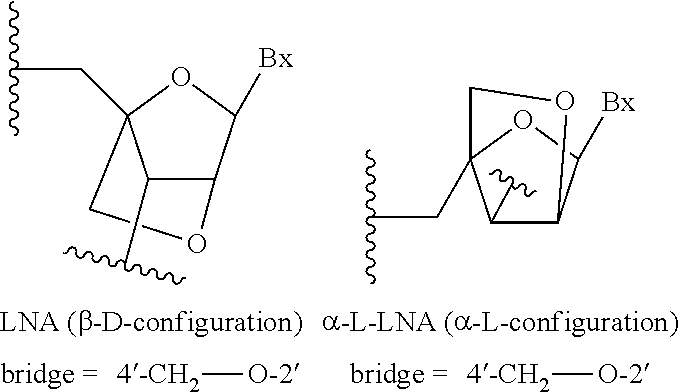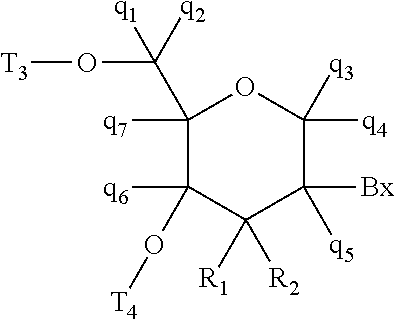Methods for reducing c9orf72 expression
a technology of c9orf72 and expression, applied in the field of reducing c9orf72 expression, can solve the problems of lack of acceptable options for treating neurodegenerative diseases, no effective therapies, etc., and achieve the effects of reducing anxiety, reducing spatial learning, and reducing symptoms
- Summary
- Abstract
- Description
- Claims
- Application Information
AI Technical Summary
Benefits of technology
Problems solved by technology
Method used
Image
Examples
example 1
Modified Oligonucleotides Targeting Human C9ORF72
[0191]The modified oligonucleotide in the table below is a MOE gapmer. The central gap segment of the gapmer contains 2′-deoxynucleosides and is flanked by wing segments on both the 5′ end and on the 3′ end containing nucleosides that each comprise a 2′-MOE group. The specific motif of the gapmer is listed in table below, represented by three numbers separated by hyphens. The numbers represent the number of nucleosides in the 5′-wing, the gap, and the 3′-wing, respectively. All cytosine residues throughout the oligonucleotide are 5-methylcytosines. The internucleoside linkages for the gapmer are mixed phosphorothioate and phosphodiester linkages. The internucleoside linkages for the gapmer are presented in the Linkage column, where ‘o’ indicates a phosphodiester linkage and ‘s’ indicates a phosphorothioate linkage.
[0192]The modified oligonucleotide listed in the table below is targeted to the human C9ORF72 genomic sequence, designated...
example 2
In Vitro Dose Response Inhibition of Human Pathogenic C9ORF72 RNA in HepG2 Cells with 672681
[0193]Compound No. 672681 was tested at various doses in HepG2 cells. Cells were plated at a density of 20,000 cells per well and transfected using electroporation with 0.11 μM, 0.33 μM, 1.00 μM, or 3.00 μM concentrations of modified oligonucleotide. After a treatment period of approximately 16 hours, RNA was isolated from the cells and C9ORF72 mRNA levels were measured by quantitative real-time PCR using human primer probe set RTS3905 (forward primer: GGGTCTAGCAAGAGCAGGTG, designated herein as SEQ ID NO: 3; reverse primer: GTCTTGGCAACAGCTGGAGAT, designated herein as SEQ ID NO: 4; probe: TGATGTCGACTCTTTGCCCACCGC, designated herein as SEQ ID NO: 5-a TAQ-man primer probe set). Primer probe set RTS3905 was used to measure the pathogenic C9ORF72 RNA, which is the product of a pre-mRNA containing a hexanucleotide repeat. C9ORF72 mRNA levels were adjusted according to total RNA content, as measured...
example 3
Inhibition of Human C9ORF72 RNA in Transgenic Mice
[0194]Inhibition of C9ORF72 RNA was tested using Compound No. 672681 in a BAC transgenic mouse line, designated herein as C9B183. The C9B183 mouse line expresses a truncated human C9ORF72 gene comprising exons 1-5. The truncated human C9ORF72 gene of the C9B183 mouse line contains 450 hexanucleotide repeats.
[0195]3-month old C9B183 mice each received a single intra cerebroventricular (ICV) stereotactic injection into the right ventricle of 350 μg of either Compound No. 672681 or a control oligonucleotide that does not target human C9ORF72 in 10 μL total volume of PBS. Each treatment group consisted of six mice. Two weeks following oligonucleotide treatment, the mice were sacrificed and spinal cord and cortex tissues were collected from each mouse. Total RNA from each tissue was isolated with TRIZOL (Invitrogen, Carlsbad, Calif.) and first-strand cDNA was synthesized using the SuperScript III First-strand synthesis kit (Invitrogen, Ca...
PUM
| Property | Measurement | Unit |
|---|---|---|
| total volume | aaaaa | aaaaa |
| depth | aaaaa | aaaaa |
| diameter | aaaaa | aaaaa |
Abstract
Description
Claims
Application Information
 Login to View More
Login to View More - R&D
- Intellectual Property
- Life Sciences
- Materials
- Tech Scout
- Unparalleled Data Quality
- Higher Quality Content
- 60% Fewer Hallucinations
Browse by: Latest US Patents, China's latest patents, Technical Efficacy Thesaurus, Application Domain, Technology Topic, Popular Technical Reports.
© 2025 PatSnap. All rights reserved.Legal|Privacy policy|Modern Slavery Act Transparency Statement|Sitemap|About US| Contact US: help@patsnap.com



